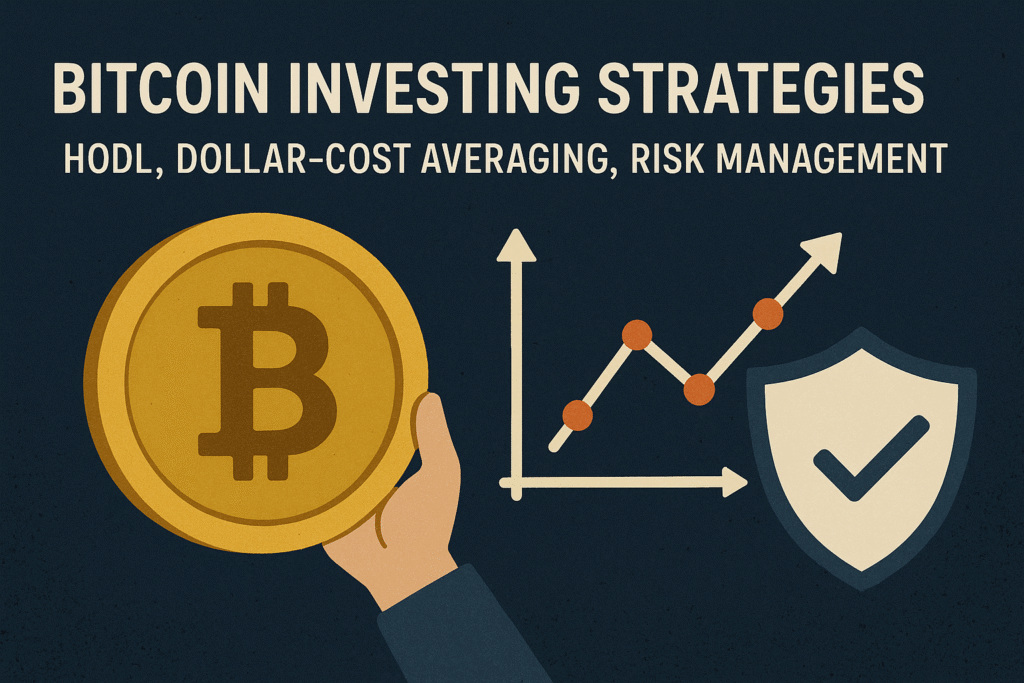Why investors consider Bitcoin
Bitcoin (BTC) is a volatile, alternative asset with a limited supply and a long-term adoption narrative that attracts both retail and institutional investors. Its price history shows large upward trends but also deep drawdowns. That combination makes investing strategy and risk control essential: without a plan you are likely to be led by emotion during big moves.
Core strategies: HODL and Dollar-Cost Averaging (DCA)
HODL
– What it is: “HODL” (hold on for dear life) means buying Bitcoin and keeping it over years or decades regardless of short-term price action. The strategy rests on a long-term bullish thesis: adoption, capped supply (21 million), and network effects will drive price higher over time.
– Pros: Simple to implement; avoids trading noise and tax-churning; historically rewarded long-term holders through multiple cycles.
– Cons: Requires strong conviction and patience; large drawdowns can be psychologically painful; timing of entry matters less but still affects eventual returns.
– Best for: Investors with a long horizon, ability to hold through drawdowns, and preference for a low-activity approach.
Dollar-Cost Averaging (DCA)
– What it is: Investing a fixed amount at regular intervals (weekly, biweekly, monthly) regardless of price. DCA smooths your average entry price over time and reduces the risk of poor timing.
– Pros: Reduces emotional timing decisions, lowers average entry during volatile downtrends, easy to automate, works well for new capital flows (e.g., monthly savings).
– Cons: If the asset is in a sustained bull market, a lump-sum at the start would have produced higher returns; DCA does not eliminate risk of losses.
– Implementation tips: Choose a cadence you can maintain (weekly/biweekly/monthly). Automate purchases via an exchange or brokerage to remove friction. Keep fees low — frequent buys on high-fee platforms can erode returns.
Combining HODL and DCA
Many investors split capital into two parts:
– Lump-sum/HODL portion: A decided amount you buy and keep as your core position.
– DCA portion: Ongoing contributions that increase your core position over time and smooth out entry price.

This mix allows you to capture potential upside from an early lump-sum while reducing regret or poor timing through continued DCA.
Risk management fundamentals
Position sizing
– Only allocate a portion of your total investable assets to Bitcoin consistent with your risk tolerance, time horizon, and financial goals.
– Sample ranges (not financial advice): conservative 1–3% of net worth, moderate 3–10%, aggressive 10–25+. Tailor these to personal circumstances; higher allocations increase volatility risk.
Avoid leverage
– Leveraged products amplify both gains and losses and are generally ill-suited for buy-and-hold strategies. Use leverage only if you fully understand margin calls and liquidation risks.
Diversification
– Diversify across asset classes (stocks, bonds, real estate), and within crypto if appropriate. Bitcoin is often treated as a distinct asset class — avoid putting your entire portfolio into any single asset.
Stop-losses and take-profits
– For long-term HODLers, fixed stop-losses can force unwanted realizations during ordinary volatility. Many HODL investors instead set mental stops or periodic re-evaluation rules.
– For active traders, use explicit stop-loss orders, position limits, and trailing stops to protect capital.
– Consider a take-profit plan: percentage-based profit-taking, scaling out in tranches, or rebalancing profits into other assets.
Rebalancing vs. buy-and-hold
– Rebalancing: Periodically sell a portion of Bitcoin when it exceeds a target allocation and buy other assets when it falls below. This enforces “sell high, buy low” discipline.
– Buy-and-hold: Less active, but you may miss opportunities to lock in gains or reduce concentration risk after big rallies.
– A hybrid approach: HODL a core base while rebalancing a smaller, tradable sleeve.

Security and custody
– Self-custody vs custodial:
– Custodial (exchanges/third-party custodians) are convenient but carry counterparty risk.
– Self-custody (hardware wallets, multisig setups) gives control and reduces custodial risk but requires careful handling of seeds and backups.
– Best practices:
– Use a reputable hardware wallet for long-term holdings.
– Never store seed phrases in plain digital form (no unencrypted cloud storage). Use physical backups in secure locations.
– Use multi-signature setups for larger balances if possible.
– Enable strong passwords and two-factor authentication (prefer app-based 2FA, not SMS).
– Keep software (wallets, OS) up to date to avoid vulnerabilities.
Tax, recordkeeping, and legal considerations
– Crypto tax rules vary by jurisdiction. Transactions (trades, spending, converting to fiat) often trigger taxable events.
– Keep detailed records of buys, sells, transfers, and fees. Use portfolio trackers or tax software compatible with crypto.
– Consult a tax professional to understand capital gains, reporting windows, and potential tax-loss harvesting opportunities.
Psychology and discipline
– Prepare for volatility: Bitcoin can fall 30–80% in bear markets. Know your plan in advance — when you will add, hold, or reduce exposure.

– Avoid chasing FOMO during sharp rallies or panic-selling during drawdowns. Rules-based strategies (DCA, scheduled rebalancing) help remove emotion.
– Set realistic expectations: price trajectories are uncertain; focus on process rather than trying to predict exact tops and bottoms.
Practical examples
– Beginner monthly DCA: Commit $200/month for 12–24 months via an automated purchase on a reputable exchange or broker.
– Core-and-satellite: Buy a core 60% HODL allocation immediately, then DCA the remaining 40% monthly.
– Rebalancing rule: Target Bitcoin at 5% of portfolio; if it rises to 8%, sell to bring back to 5% and distribute proceeds into underweight assets.
Checklist before you buy
– Clear financial priorities: emergency fund, high-interest debt under control.
– Defined allocation: know how much of your net worth you’re comfortable allocating.
– Custody plan: where will you store coins long-term?
– Security measures: hardware wallet, backups, 2FA.
– Tax awareness: how transactions will be reported in your jurisdiction.
– Emotional readiness: can you tolerate big drawdowns and stick to your plan?
Closing thoughts
Bitcoin offers opportunity but comes with pronounced volatility and operational risk. HODL and DCA are complementary, low-friction ways to participate: HODL captures long-term upside while DCA reduces timing risk and emotional trading. Risk management — position sizing, secure custody, diversification, and tax planning — is the crucial counterpart that protects capital and preserves optionality. Define your goals, write a clear plan, automate what you can, and review periodically as circumstances change.
Disclaimer: This article is educational and not personalized financial advice. Consult a licensed financial advisor and a tax professional for guidance tailored to your situation.

